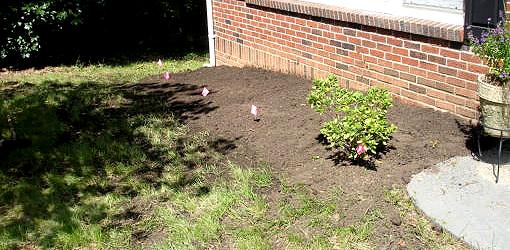How To Plant And Organic Garden In A Soil That Has Been Spread With Chemicals To Kill Weeds

For best results, improve the soil in the entire planting area.
When I go to the garden center, after loading my cart with flowers and bushes, I head straight for the soil aisle to pile on bags of manure, soil conditioner, and all the wonderful things that I believe will make my plants happy. But is amending the soil around garden plants really a good idea? Here's the scoop on how to – or not to – improve the soil in your garden.
Does Adding Amendments to Soil Really Work?
When I dig into the hard red clay soil in my yard, it's hard to believe that anything will grow, much less thrive, in such poor conditions. Plants need organic matter, air circulation, and proper drainage, and my soil is lacking in all of the above. So my standard practice has been to dig a hole, sit the new plant in place, and backfill the hole with rich organic matter such as manure or compost, and I felt darn proud of the job, too.
But when we amend the soil right around our plants, what happens? In short, we create a pocket of permeable, well-aerated, nutritious soil, surrounded by a wall of inhospitable native soil. And from what we know about plants and soil ecology, the plant roots (and the water, nutrients, and air) have trouble with boundaries.

The tiny feeder roots of the plant will resist spreading out beyond the barrier and instead grow inward in a tight circle. Water will quickly be wicked away into the native soil, or worse, will collect in the basin in what's known as the "bathtub effect." So we're left with a tight ball of roots crowded in a pocket of rich soil that's considerably wetter (or drier) than the surrounding soil. Basically, we're left with a rootbound potted plant! And an unhappy one, at that.
How to Amend Your Garden Soil
Nowadays, any conversation on this topic tends to dissolve into a hopeless argument between the "do-digs" and the "don't-digs." Some believe soil amendments are vital to growing healthy plants, while others believe that if it won't grow in your native soil, you shouldn't be planting it. But if you want to grow plants or vegetables, and your native soil is of poor quality, what's a gardener to do?

Take the time to dig a large hole when planting shrubs.
To keep your plants happy, all it takes is a little more thought, and a little more digging. Follow these tips to help the plants in your garden grow:
- Choose Plants Wisely: Seek out plants that are well-suited to your native soil. For example, if your soil is clay, don't try growing coastal plants that are suited for sandy soil. This simple shift will make gardening much easier and ensure that your plants are healthy long after those soil amendments rot away.
- Improve All Soil: If you're going to amend your soil, try to amend all of it, rather than just improving the soil right around each plant. Raised beds are a great way to improve the soil for large-scale plantings, or you can till up an entire area and replace or amend all the soil. For annual and perennial beds and lawns, amend the soil about a foot deep.
- Dig Big Hole: For deeply planted trees and shrubs where all over amendment isn't possible, dig the largest planting hole you can. I plant shrubs in a hole no less than three feet in diameter, and yes, that's a lot of digging!
- Don't Overdo Amendments: The biggest problem with soil amendment comes from the extreme difference in texture between the amended and native soil. Mix small amounts of amendments into a generous helping of native soil to keep the boundary from being so shocking to the plant roots.
Further Information
- The Myth of Soil Amendments (Washington State University)
- Top-Dressing to Improve the Soil in Your Yard (article)
- Soil Evaluation (video)
How To Plant And Organic Garden In A Soil That Has Been Spread With Chemicals To Kill Weeds
Source: https://todayshomeowner.com/how-to-amend-soil-around-shrubs-and-garden-plants/
Posted by: arndtthemen.blogspot.com

0 Response to "How To Plant And Organic Garden In A Soil That Has Been Spread With Chemicals To Kill Weeds"
Post a Comment